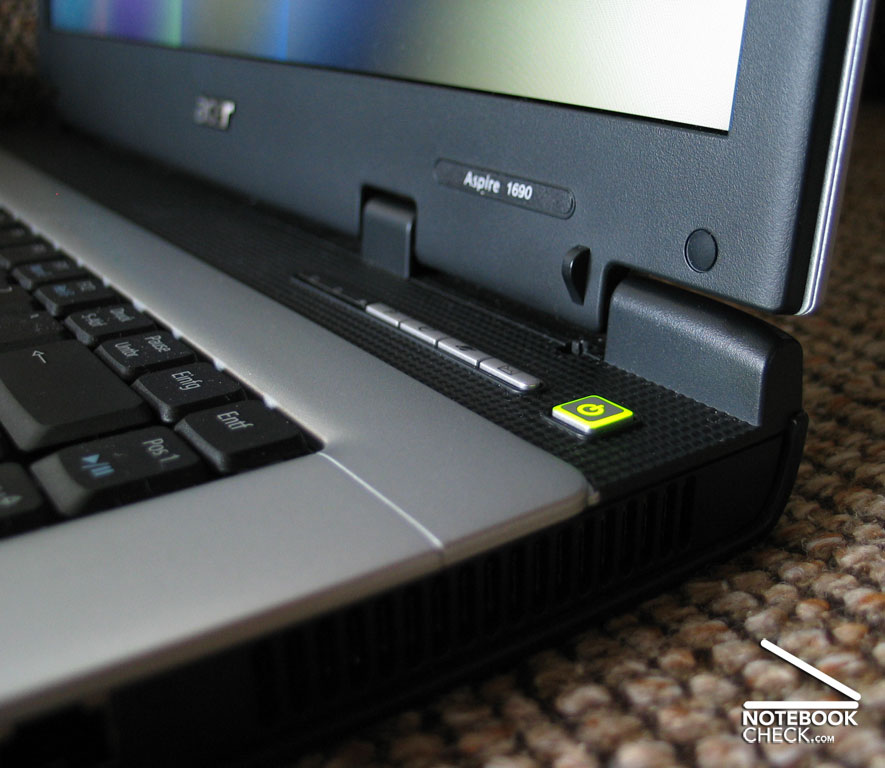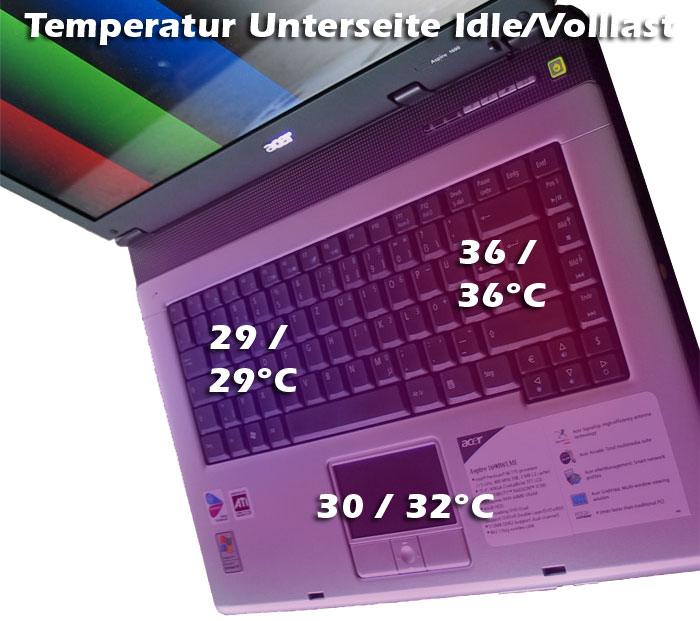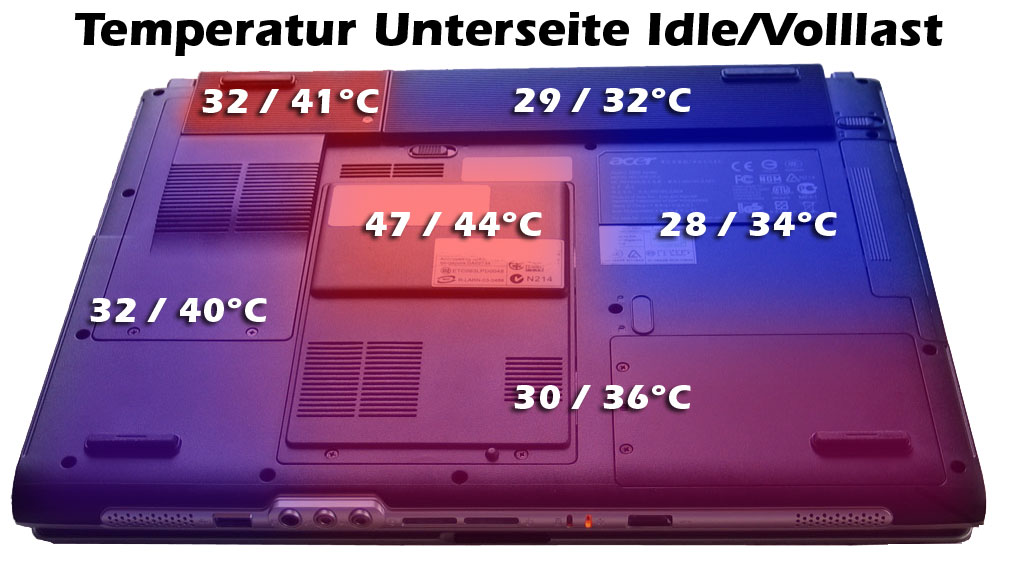|
At present Acer attracts the customers with the favorable entrance series Acer Aspire 1690, which bring along an efficient X700 video card of ATI and a reflecting broad screen despite the cheap price. In our test we will examine whether the features are as well as promised and which details were economized.
Our test model Acer Aspire 1690WLMi exhibited the following equipment :
- Processor: Intel Pentium M 715 (Dothan) 1.50GHz
- Chip set: Intel i915PM/GM/GMS rev. 3, Southbridge Intel 82801FBM (ICH6-M) rev. 4
- Memory: 2x DDR2-SDRAM 256 MBytes PC3200 dualchannel (3-3-3-8) of Hyundai Electronics
- Optical drive assembly: Pioneer DVD RW DVR-K05RA dvd+r doubles Layer/dvd+ rw
- Display: 15.4"WXGA CrystalBrite TFT LCD (1280x800 pixel resolution)
- Video card: ATI Mobility Radeon X700 PCI Express with 64MB VRAM (344 MHz memory -, 358 MHz core clock)
- Hard disk: UATA/100 Toshiba MK6025GAS 60 GB (55.9 GB formated)
- Wireless network: 802.11 b/g Wireless LAN, intel 2200bg
 | | This area distorts, if the hinge of the display is used. |
Network: Broadcom NetXTreme Gigabit Ethernet Controller (10/100/1000 MBit) - 56k modem
- Texas Instruments IEEE 1394 Firewire controllers (right side in front)
- 4in1 Card reader (SD/MMC/MSMS pro)
- 63360mWh left-ion-Akku
- 3 x USB (2 x right, 1x in front)
- Software: Windows XP Home, Acer tools for energy management etc.
- Weight: 3.1 kg of the notebook inclusive accumulato + 0.4 kg power pack inclusive cables, easy and small
(manufacturer data: 2.95 kg)
Unfortunately the USB connections on the right side and in front are very much disturbing for right-handers, since using a mouse collisions with the cables are unavoidable. The front one connection is practical, if you do not need more than to attach something fast (memory stick e.g.). However it is often needed for longer (the Laptop only offers the 2 further ones on the right side) and so this is also at least optically unpleasant.
 | | Front |
|  | | Left side |
|  | | Rear side |
|  | | Right side |
|
The 512 MB memory of the Acer Aspire 1690WLMi consists of 2x256 MB bars. This is favorable for the performance, since they are controlled in dual-channel operation. However at least one bar must be exchanged for upgrades.
Workmanship & Design | | Broad and pleasantly usable Touchpad |
The Design is the well-known silver and black Design of Acer and at present maintained over all series, which already the predecessor 1680 introduced. It looks pleasing but not necessarily high-quality. The case of our Acer Aspire 1690WLMi test equipment was relatively stiff against tosions except one area. If the display inclination is changed (for instance when closing the equipment), the entire top side of the case moves somewhat upward. This could lead to problems during long-term use (gaps and cracks). On the other hand creaking could not be discovered it is hardly possible to dent the surface by pressure.
In addition to the already mentioned bad-positioned connections a disadvantage of the design of the case is the opening of the ventilator at the bottom side. Therefore unfortunately an application on a soft surface is hardly possible. Furthermore, like with the predecessor, a stand is placed on the easily removable accu and therefore the equipment does not stand completely stable without Accu. Keyboard | | Keyboard of the 1690WLMi |
The keyboard pleased with a pleasant control comfort. A quiet clicking noise can be heard (for me pleasant) using the keys, which are comfortable large.DisplayThe 16:10 broad display with a resolution of 1280x800 pixel impressed us with very fast switching times. So in games, videos or during scrolling hardly any streaks could be noticed. Even the flag test with Pixperan showed only slightly smeared edges. The illumination results in 80,9 % and is average for the laptops, which we tested up to now. The exact measured values of the Aspire display can be examined here:
127,8 | 147,0 | 125,4 | 124,6 | 138,2 | 118,9 | 136,6 | 132,6 | 127,7 |
Illumination table of the display
(values in cd/m�).
The stability of the point of view is moderate and the display loses colors fast with horizontal movements and changing angles.
 | | Original picture |
|  | | Frontal view |
|  | | Horizontal the display loses fast colors |
|  | | All gets brighter |
|  | | Relative stable colors |
|  | | Extreme point of view |
|
Here still the measured parameters of the display (warm colour in the curves visible)
 | | Screen characteristics |
PerformanceBecause of the powerful video card ATI Radeon Mobility X700 (unfortunately only 64 MB RAM) the equipment reaches very good test values with synthetic bench mark. With current games the slowly clocked Pentium M (1.5 Ghz in the 1690WLMi) brakes the grafic card out. Therefore (and because of the 64 MB of the Radeon) cannot be played everything fluently with the maximum settings. The stronger versions 1693 and 1694 with more grafic RAM are probably for all current games prepared. In the following table you can get the exact test values of the synthetic benchmark (all benchmark with standard settings, 1024x768): | 3D Mark of 2001 | 3D Mark of 03 | 3D Mark of 05 | | 15288 points | 5163 points | 1540 points | | | | | | PC Mark of 04 | Aquamark 3.0 | | 3109 points | 40679 (GFX: 5397. CPU: 8262)
starting from 20000 Aquanox2 is playable in high |
Cinebench 2003
Rendering (single CPU): 199 CB-CPU
Rendering (multiple CPU): -- CB-CPU
Shading (CINEMA 4D) : 237 CB-GFX
Shading (OpenGL software Lighting): 1049 CB-GFX
Shading (OpenGL hardware Lighting): 2685 CB-GFX
OpenGL Speedup: 11.34
HD Tune
 | | HD Tune diagram, blue = transfer rates, yellow = access times |
That hard disk-benchmark evaluates the Toshiba MK6025GAS 60 gigabyte non removable disk of the Acer Aspire 1690 in our test equipment:
Transfer rate minimum: 7,5 MB/sec
Transfer rate maximum: 24,9 MB/sec Transfer rate average: 21,2 MB/sec
Access time: 18,9 ms
Burst rate: 65,7 MB/sec CPU Usage: 4.2%
SiSoftware Sandra
As expected the benchmark-suite Sandra supplies used good values for the Centrino package. Here the exact values:
CPU arithmetic benchmark combined index: 8515 (altogether)
CPU multimedia benchmark combined index: 29906 (altogether)
Memory ranges benchmark combined index: 4739 (altogether)
File system benchmark combined index: 20400 (altogether)
CPU arithmetic (as expected for 1.5 Pentium M)
Dhrystone ALU: 6431 MIPS
Whetstone FPU: 2076 MFLOPS
Whetstone iSSE2: 2659 MFLOPS
CPU Multimedia (as expects for 1,5 Pentium M)
Integer x4 iSSE: 14176 it/s
Float x4 iSSE2: 15671 it/s
Quake 3 Arena:
 | | Front |
The timedemo benchmark (Four.DM_68) resulted in 235.7 fps (pictures per second) in 1024x768 with highest attitudes. Not surprisingly this shows that the Quake 3 is playable very well in highest resolutions and settings with the Acer Aspire 1690WLMi .
Unreal Tournament 2004:
In the single player mode 1vs1 the notebook rendered sensational 80-100 fps (all max 1280x800). In the multiplayer game with 23 Bots however very jerky movements were noticed and fluent playing was not really possible (although over 30 fps). This indicates a too slowly clocked processor for the many computations. Here the versions with a more powerful CPU surely would get better results. Here are the exact test values of the primeval timedemos:
Resolution
(pixels) | High image quality
(fps) | High performance
(fps) | | 1280x1024 | 27,3 | 61,4 | | 1024x768 | 28,2 | 60,7 | | 800x600 | 28,2 | 60,4 | | 640x480 | 28,4 | 59,1 |
Doom 3
Still with the setting "high" Doom 3 was well playable but with several jerky movements. The Timedemo Benchmark delivered the following results:
| Setting | Result (in fps) | | Low (640x480) | 48,6 | | Medium (800x600) | 49,7 | | High (800x600) | 31,0 | | Ultra (1024x768) | 22,8 |
Half Life 2
Halflife 2, which well-known-proves runs very well on ATI video cards, is perfectly playable on the Aspire 1690, as prove following benchmark.
| Time demo | fps | | Time demo | fps | | Coast | 58,6 | | d3c171 | 43,7 | | demo4 | 99,6 | | d3c171 (8 AF) | 40,7 | | demo5 | 85,4 | | d3c171 (16 AF) | 38,5 | | demo6 | 74,6 | | d3C171 (16 AF, 6 AA) | 21,6 |
Benchmark values with a resolution of 1024x768 with the highest settings The Counter Strike Source stress test resulted in very good 91.81 fps (1024x768 settings high).
Current consumption | | Bottom surface with removed accu (does not stand any longer stably) |
The current consumption is relative moderate for the ATI Mobility Radeon X700 video card. Here the exact values of consumption of our tests:
Idle, Powerplay optimal performance (357 MHz core clock, 344 MHz memory steps): 27 Watt
Idle, Powerplay balanced (209 MHz core clock, 182 MHz memory steps): 22 Watt
Idle, Powerplay optimal battery life (104 MHz core clock, 120 MHz memory steps): 21.7 Watt
Idle, Powerplay optimal battery life, min brightness (min brightness still well usable): 18.1 Watt
Idle, Powerplay optimal battery life, min brightness, min CPU frequency (455 MHz - max 1133 MHz): 17.4 Watt
Idle, Powerplay optimal battery life, min brightness, min CPU frequency, WLAN deactivated: 16.4 Watt
Cardbus, LAN, Firewire did not bring improvement (without docked devices).
optical mouse = 0.4 Watt
Doom3, everything switched on (full load): 60 Watt
Duration of Supply by AccuThe 63360 mWh lithium ions-Accu showed the following running times in the battery benchmark Batteryeater:
Classic test (all settings on maximum performance, full load test): 1h 19 min
Reader test (all settings on minimum performance, brightness at minimum is sufficient): 3h 34 min
TemperatureThe top side remains relative cool (maximum 36�C) and is not unpleasant. Under load certain areas on the bottom surface heat up to 44�C, this could be unpleasant with the operation on the lap (because of the ventilator openings at the bottom this is not recommended). You can get exact heat data from the pictures below. Addon: The hard disk heated up to 50�C after the hard disk test. Volume | | Nearly all connections are on the right side (for right-handers disturbing) |
We accomplished our volume tests 10 cm in front of the equipment on the table. Unfortunately the ventilator nearly always runs on stage 1 and therefore produces a relative high noise in idle condition. We measured the following values:
Ambient noise in a very quiet area: about 28-30 dB
Idle without ventilator (rather rare, ventilator often switches itself on): 31,9 - 32.5 dB
Idle without ventilator + hard disk operation: 36 - 39.6 dB Ventilator stage 1 (runs frequently, also often in the idle condition): 38,4 - 38.9 dB
Ventilator stage 2 (only during strong Prozessor/grafic card load): 47,5 - 48.8 dB
CDROM (install procedure): 53 dB Sound | | Acer Aspire 1690WLMi with broad display |
The loudspeakers unfortunately miss any bass and are barely sufficient for a representation of film and/or DVD. Hearing music really is not a pleasure with this sound system. Here external loudspeakers are recommended.ResultAcer Aspire 1690 WLMI is a favorable racer. In our equipment only the processor limited the laptop. Versions with stronger processor (1691WLMi, 1692WLMi, 1692WLMi, 1694WLMi) should be able to perform all current games without problems (particularly the versions with 128 MB video RAM). Here are the most important positive and negative aspects, which were noticed during the test:
| Positive | Negative | | Display | Volume | | Performance | Weight | | Price | Workmanship (Hinges) | | Heat Emission | Stand on Accu |
|






















